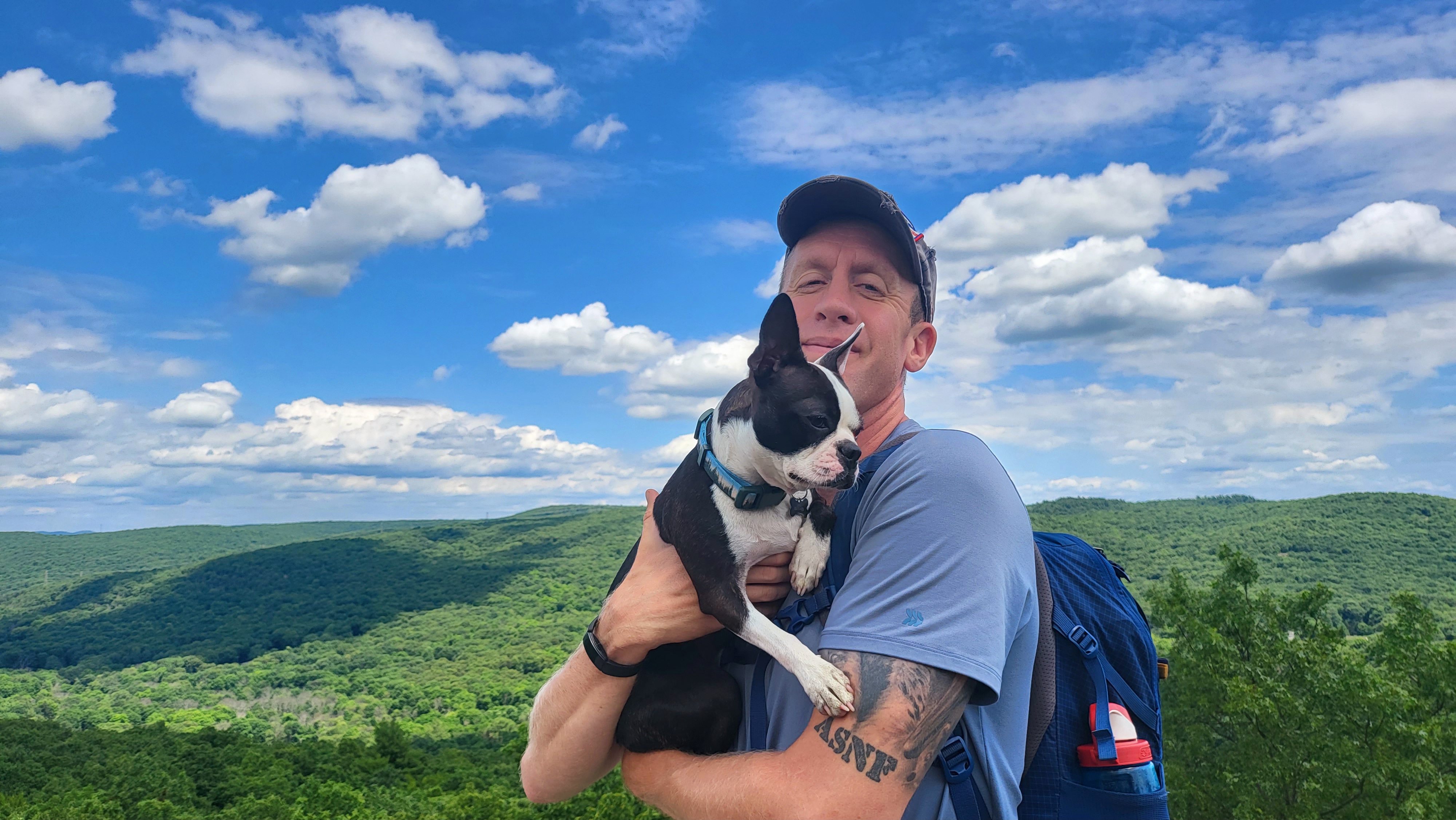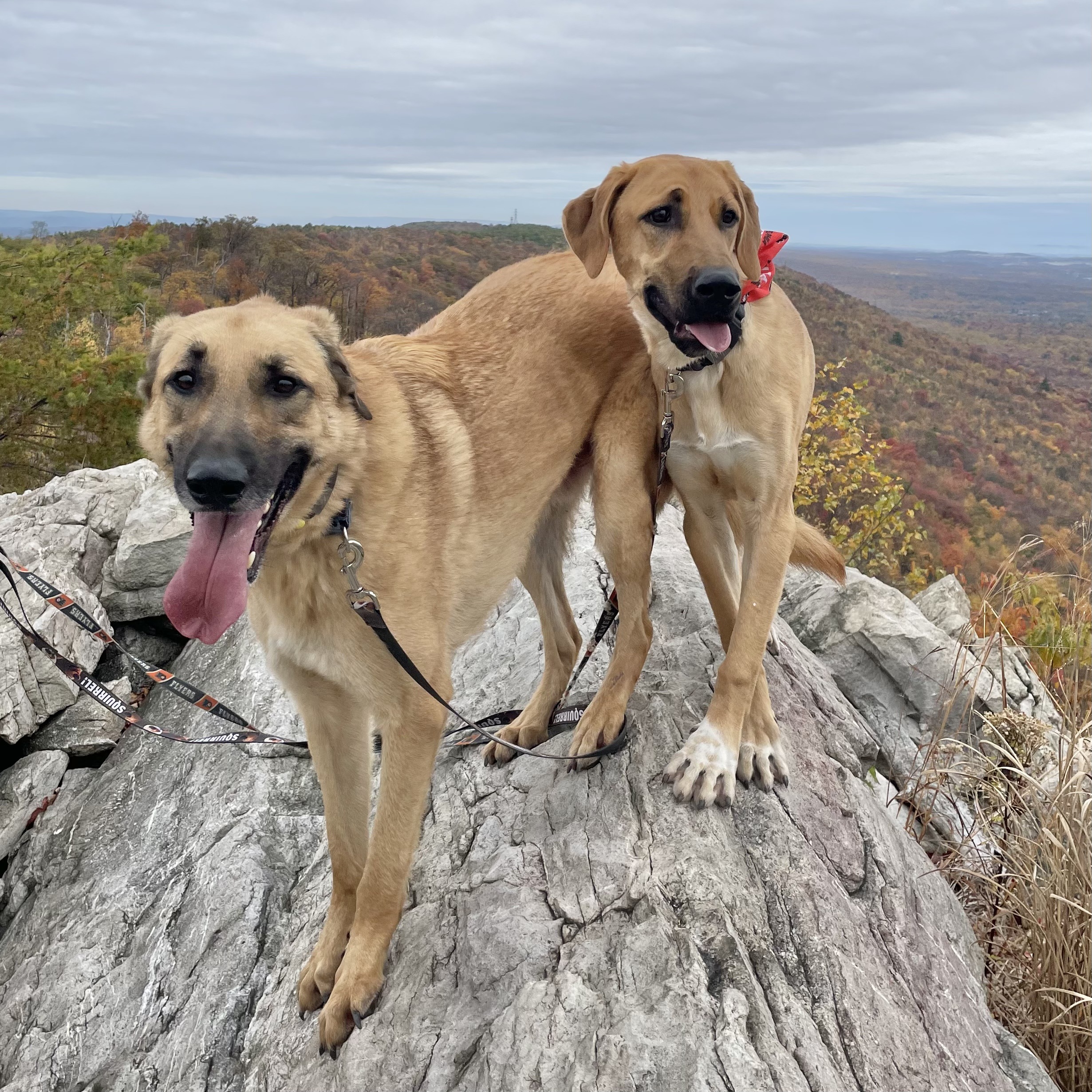By Maria "Wheezy Pee" Wishart
Hiking with a Dog on the Appalachian Trail
August 24, 2023
Are you thinking about hiking with your dog on the Appalachian Trail? Whether you’re planning a day hike, overnight, section hike or thru-hike, there are some things to do and consider before you and your dog step foot (or paw) on the Trail.

Photo by Brad “Jaws” Gibson with Oreo the Boston Terrier
The first and one of the most important things is to remember that your hike is not your own — it’s your dog’s hike too! Because you are solely in charge of your dog’s comfort level and health, you may need to avoid popular trails at peak times, keep your mileage short, choose a time of day or season based on your dog’s ability to handle heat or cold, or take multiple breaks for their benefit. On longer hikes, planning for your pup may be more difficult. For example, some hostels and hotels may not be pet friendly or they may have pet fees. You will also need to plan for your dog when you stop in town to resupply. This blog post highlights the basics of how to plan your hike with your dog’s needs at the forefront of your decision making.
Prioritize Health and Safety
Before you take your dog on the Trail, talk with your vet about your dog’s health, age, and breed in relation to their suitedness for hiking and carrying a backpack. Make sure your dog is fully vaccinated and get enough tick and heartworm prevention to last the duration of your trip.
For your dog’s health and safety, they should be physically conditioned for the terrain they’ll need to handle on the hike. When your dog is ready for training, begin with short hikes and build up mileage as your dog’s breed and fitness will allow. If your dog is carrying a backpack, start with the pack empty and slowly add weight. Be sure to not exceed the recommended weight (about 10-12% of your dog’s weight at most).
Be Considerate of Others
It’s no secret that there are hikers who have had bad experiences with dogs on the Trail. If you’re planning to hike with your dog, it’s your responsibility to be considerate of others’ experiences. This means spending time training your dog on vital behaviors like leaving wildlife alone, not greeting without permission, not begging for food, and staying away from people’s gear at shelters. It’s also helpful to do some exposure training to the things your dog is likely to encounter on the Trail like trekking poles, large backpacks, deep water, stream crossings, and tents. Some people may pet your dog without permission as they walk by. It’s a good idea to get your dog comfortable with this as it is bound to happen, especially on a trail as popular as the A.T.
Being a good steward also means keeping your dog leashed. Work with your dog on loose leash walking and directional cues such as heel to left or right, front, or behind. Keeping your dog leashed keeps them safe from wildlife like bears, porcupines, and snakes, and makes other hikers feel more comfortable. Not to mention, leashes are required on many sections of the Appalachian Trail.
Other ways to be a good steward are to teach your dog appropriate trail etiquette such as yielding to uphill hikers and practicing Leave No Trace principles like giving wildlife space, staying on the Trail, and picking bathroom stops that are 200 feet from the Trail and water sources.

Photo by Alyssa “S.G. GAME12” Stauffer near Little Gap
Pack for Your Dog
Because safety is the priority, always bring a dog first aid kit that contains pain relievers, a rescue harness, vet tape, gauze pads, antiseptic wipes, hydrogen peroxide, antibiotic spray or ointment, eye wash, and paw butter. Your dog will also likely need a sleeping bag or quilt, bowls for food and water, a sleep pad, rain gear, microfiber towel, and booties (especially for rocky terrain). Several manufacturers even make ultralight dog gear options!
Be Mindful on the Trail
Once you’re on Trail, keep a close eye on your dog’s physical condition. Are they looking lethargic or slowing down considerably? Are they stopping to lay down or limping? Are you noticing signs of stomach distress like vomiting or diarrhea? Keep a close eye on your pup and make sure they are staying well hydrated. Signs of dehydration include loss of skin elasticity, loss of appetite, vomiting, reduced energy levels, panting, sunken, dry looking eyes, dry nose, dry sticky gums, and thick saliva. Be sure to give your dog proper nutrition with calorie-dense, high-protein foods, vitamin supplements, and daytime snacks. Also take note of any changes in their mental or emotional health and always adjust your plan for the health, safety, and well-being of your dog.
All this said, there is nothing like including your furry friend on your Appalachian Trail adventures. With thought, planning, and proper training, you and your dog can live your best lives together following those white blazes.
Discover More

BACK TO THE BASICS
Leave No Trace
Wondering how you can take care of outdoor places like the Appalachian Trail (A.T.)?

Plan and Prepare
Hiker Resource Library
A collection of resources for hikers to stay safe, healthy, and responsible on the Appalachian Trail.

Plan Your Visit
Explore by State
Learn more about each of the 14 states the Appalachian Trail passes through, from cool facts to essential information for your next hiking trip.
